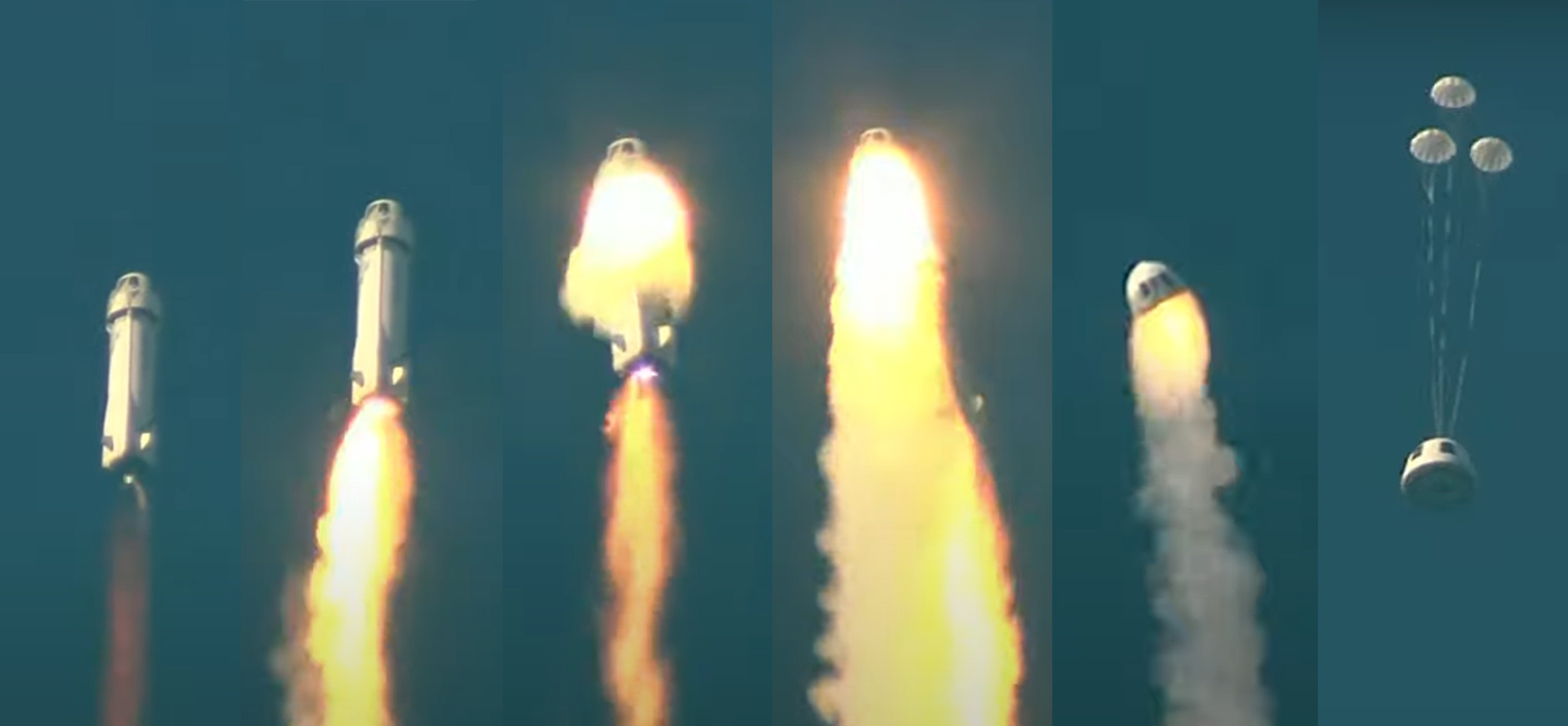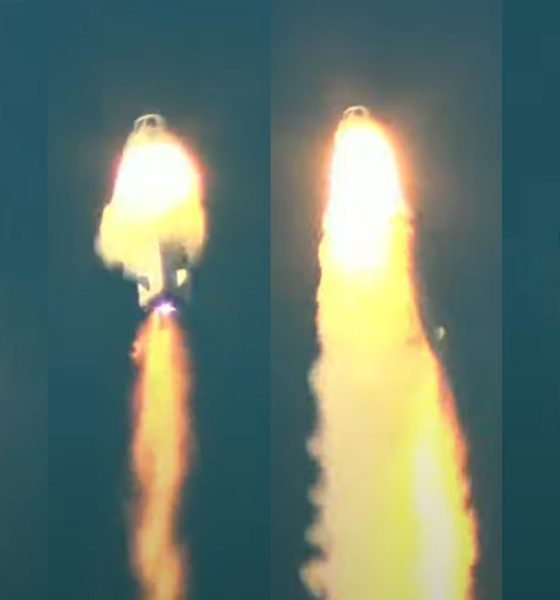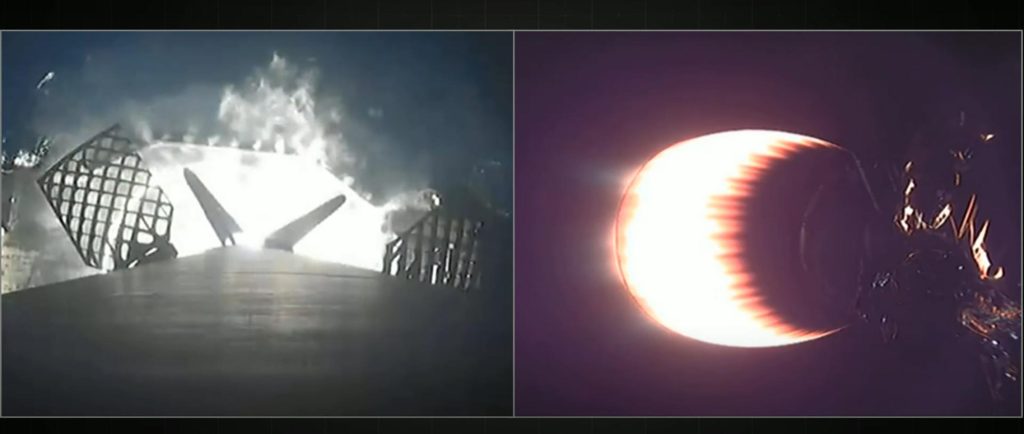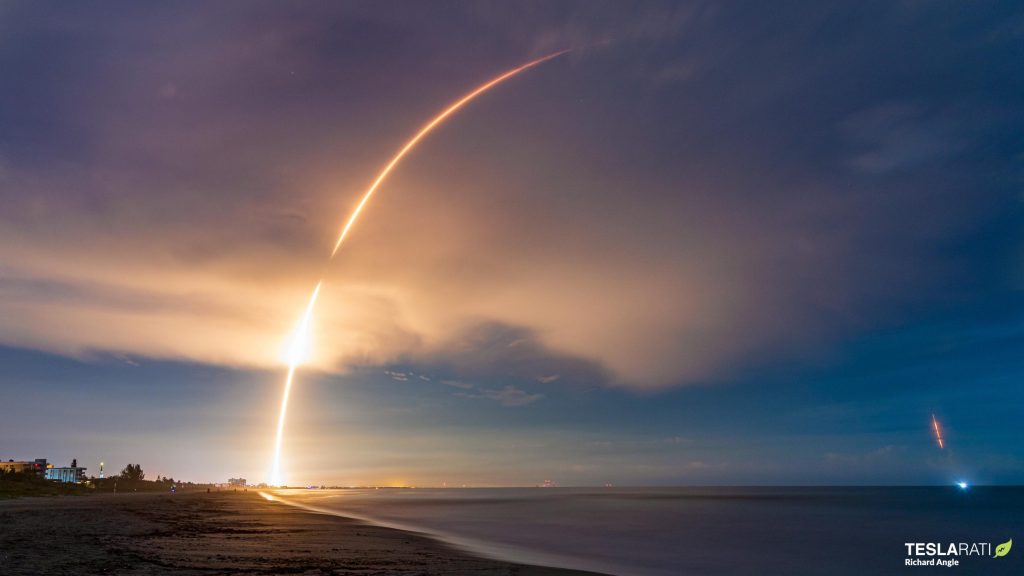

News
Blue Origin rocket launch fails after engine catches fire
Blue Origin’s suborbital New Shepard rocket suffered a catastrophic engine failure during its 23rd launch attempt, ending a seven-year streak of 21 successes.
Following a handful of mostly weather-related delays that pushed New Shepard’s 23rd launch about two weeks past its original August 31st target, the single-stage vehicle lifted off from Blue Origin’s Van Horn, Texas launch site around 10:25 am CDT (14:25 UTC) on September 12th. Measuring about 15 meters (49 ft) tall, 3.7 meters (12.1 ft) wide, and capable of producing about 50 tons (~110,000 lbf) of thrust with its lone BE-3 engine at full throttle, New Shepard only made it about halfway through its nominal powered ascent before catastrophe struck.
The first signs of trouble appeared about 62 seconds after liftoff in the form of flickers and flashes in New Shepard’s exhaust, which is normally almost transparent. Less than two seconds after the first seemingly harmless flash, flames unintentionally burst from New Shepard’s engine section and quickly surrounded its BE-3PM engine. Less than a second after that, the rocket’s aft and began shedding pieces and stopped producing thrust, triggering a solid rocket motor stored inside its deployable capsule.
About a second after the incident began, the capsule’s abort motor ignited and carried the suborbital spacecraft safely away from the failing New Shepard booster. The capsule ultimately coasted to an apogee of 11.4 kilometers (7.1 miles) – almost ten times lower than nominal – before descending back to Earth, deploying its parachute system, and safely touching down in the Texas desert scrub. Thankfully, NS-23 was only carrying experiments, and no humans were at risk. Had a crew of suborbital tourists been aboard, they would have likely been a little battered but otherwise completely unharmed.
..there is room for a lot of speculation ?– i did a frame by frame Picture – on the bottom row you can see some parts falling away. maybe the nozzle fell apart?!? pic.twitter.com/OOzPkPiX6G— Flo (@FloSpacenerd) September 12, 2022
While any failure of a rocket is unfortunate, the failure of a rocket nominally designed to launch humans can have even worse repercussions. However, thanks to the seemingly flawless unplanned performance of New Shepard’s abort system, it’s safe to say that the day could have gone much worse for Blue Origin.
The failure is still not going to do the reputation of Blue Origin or New Shepard any favors. It also invites less than favorable comparisons with SpaceX, a different spaceflight startup also funded and founded by a tech tycoon in the early 2000s.
Founded a year and a half after Blue Origin, SpaceX, in comparison, reached orbit with Falcon 1 in 2008. In June 2010, it successfully debuted Falcon 9, an orbital-class rocket roughly 20 times larger. In 2012, Falcon 9 successfully launched an orbital Dragon spacecraft which became the first private vehicle to dock to the International Space Station. In January 2015, it attempted to recover a Falcon 9 booster for the first time. In December 2015, one month after Blue Origin’s first successful New Shepard landing, SpaceX aced its first Falcon 9 booster landing.
Nine months later, Falcon 9 suffered a catastrophic failure during prelaunch testing in September 2016 and didn’t return to flight until January 2017. That is where, for the most part, the paths of Blue Origin and SpaceX almost entirely diverged – but not in any obvious way. Instead, after a successful suborbital launch in October 2016, New Shepard didn’t fly again until December 2017. In the roughly six years between October 2016 and September 2022, New Shepard completed 10 uncrewed suborbital launches, 6 suborbital tourist launches, and suffered one failure during another uncrewed mission – 18 total launches.
Despite suffering a catastrophic failure that destroyed a customer’s multimillion-dollar satellite in September 2016, SpaceX returned to flight four months later, completed 150 orbital Falcon launches without fail in the same period; debuted the world’s largest operational rocket, Falcon Heavy, and completed two additional launches with it; debuted Crew Dragon and Cargo Dragon 2 on Falcon 9; launched its first astronauts into orbit, launched its first operational astronaut transport mission for NASA, launched its first two Starlink internet satellite prototypes, launched another 60 refined Starlink prototypes, began operational Falcon 9 Starlink launches, built and launched more than 3000 Starlink satellites total; landed 130+ Falcon boosters, and reuse Falcon boosters 117 times.


The differences could not be more stark or strange, given that both companies have been operating more or less side by side and working towards similar goals for as long as they’ve existed. To Blue Origin’s credit, the company managed a record six New Shepard launches – three carrying tourists – in 2021. NS-23 was its fourth planned launch in 2022, suggesting that it could have achieved a similar cadence this year if the mission had had a different fate. Instead, the launch failure has triggered an anomaly investigation that will search for the root cause and try to uncover shortcomings that will then need to be rectified before New Shepard can return to flight. Given that Blue Origin once went 15 months between successful New Shepard launches, it’s impossible to say how long that process will take.
In the meantime, the apparent failure of New Shepard’s BE-3PM engine could trigger investigations into Blue Origin’s other engine programs. While substantially different, BE-3U, a variant optimized for the upper stage of New Glenn, Blue Origin’s first orbital rocket, likely shares the most in common with New Shepard’s BE-3PM. BE-7, a small engine meant to power a Moon lander, could also be impacted.
Most importantly, Blue Origin is also in the midst of finally preparing two much more powerful and far more complex BE-4 engines for customer United Launch Alliance (ULA). Years behind schedule, Blue Origin completed the first two theoretically flightworthy BE-4 engines and began putting them through qualification testing earlier this year. It wants to ship those engines to ULA as soon as possible to avoid delaying the debut of the customer’s new Vulcan Centaur rocket. BE-3PM and BE-4 probably don’t share a single part, but many Blue Origin employees have likely worked on both programs, and the same Blue Origin leadership has certainly overseen both. As long as there’s any form of commonality, no matter how abstract, there’s always a risk that the underlying cause of problems in one program could be present in others.
Ultimately, it’s unlikely that there will be any serious connection. The New Shepard booster that failed on NS-23 was almost five years old and was flying for a record-breaking ninth time. It’s possible that Blue Origin was privately worried about the possibility of failure while pushing the envelope, but it offered no qualifications while discussing the mission. SpaceX CEO Elon Musk, in comparison, has almost always made it clear that failure is a possibility when the company attempts ‘firsts’ of any kind.
SpaceX recently launched and recovered the same Falcon 9 booster for the 14th time, setting its own internal record. As a result, that lone Falcon 9 booster, B1058, has flown as many times in the last 31 months as all New Shepard boosters combined have flown in the last 45 months.
Finally, while no company should be put in that position, Blue Origin deserves praise for its live coverage of the anomaly. Instead of immediately cutting the feeds, which would be what most providers would be expected to do during an operational launch, Blue Origin continued to broadcast views of the failure and provide live commentary until New Shepard’s capsule touched down well ahead of schedule.

News
Waymo sues Santa Monica over order to halt overnight charging sessions
In its complaint, Waymo argued that its self-driving cars’ operations do not constitute a public nuisance, and compliance with the city’s order would cause the company irreparable harm.

Waymo has filed a lawsuit against the City of Santa Monica in Los Angeles County Superior Court, seeking to block an order that requires the company to cease overnight charging at two facilities.
In its complaint, Waymo argued that its self-driving cars’ operations do not constitute a public nuisance, and compliance with the city’s order would cause the company irreparable harm.
Nuisance claims
As noted in a report from the Los Angeles Times, Waymo’s two charging sites at Euclid Street and Broadway have operated for about a year, supporting the company’s growing fleet with round-the-clock activity. Unfortunately, this has also resulted in residents in the area reportedly being unable to sleep due to incessant beeping from self-driving taxis that are moving in and out of the charging stations around the clock.
Frustrated residents have protested against the Waymos by blocking the vehicles’ paths, placing cones, and “stacking” cars to create backups. This has also resulted in multiple calls to the police.
Last month, the city issued an order to Waymo and its charging partner, Voltera, to cease overnight operations at the charging locations, stating that the self-driving vehicles’ activities at night were a public nuisance. A December 15 meeting yielded no agreement on mitigations like software rerouting. Waymo proposed changes, but the city reportedly insisted that nothing would satisfy the irate residents.
“We are disappointed that the City has chosen an adversarial path over a collaborative one. The City’s position has been to insist that no actions taken or proposed by Waymo would satisfy the complaining neighbors and therefore must be deemed insufficient,” a Waymo spokesperson stated.
Waymo pushes back
In its legal complaint, Waymo stated that its “activities at the Broadway Facilities do not constitute a public nuisance.” The company also noted that it “faces imminent and irreparable harm to its operations, employees, and customers” from the city’s order. The suit also stated that the city was fully aware that the Voltera charging sites would be operating around the clock to support Waymo’s self-driving taxis.
The company highlighted over one million trips in Santa Monica since launch, with more than 50,000 rides starting or ending there in November alone. Waymo also criticized the city for adopting a contentious strategy against businesses.
“The City of Santa Monica’s recent actions are inconsistent with its stated goal of attracting investment. At a time when the City faces a serious fiscal crisis, officials are choosing to obstruct properly permitted investment rather than fostering a ‘ready for business’ environment,” Waymo stated.
News
Tesla FSD v14.2.2 is getting rave reviews from drivers
So far, early testers have reported buttery-smooth drives with confident performance, even at night or on twisty roads.

Tesla Full Self-Driving (Supervised) v14.2.2 is receiving positive reviews from owners, with several drivers praising the build’s lack of hesitation during lane changes and its smoother decision-making, among others.
The update, which started rolling out on Monday, also adds features like dynamic arrival pin adjustment. So far, early testers have reported buttery-smooth drives with confident performance, even at night or on twisty roads.
Owners highlight major improvements
Longtime Tesla owner and FSD user @BLKMDL3 shared a detailed 10-hour impression of FSD v14.2.2, noting that the system exhibited “zero lane change hesitation” and “extremely refined” lane choices. He praised Mad Max mode’s performance, stellar parking in locations including ticket dispensers, and impressive canyon runs even in dark conditions.
Fellow FSD user Dan Burkland reported an hour of FSD v14.2.2’s nighttime driving with “zero hesitations” and “buttery smooth” confidence reminiscent of Robotaxi rides in areas such as Austin, Texas. Veteran FSD user Whole Mars Catalog also demonstrated voice navigation via Grok, while Tesla owner Devin Olsen completed a nearly two-hour drive with FSD v14.2.2 in heavy traffic and rain with strong performance.
Closer to unsupervised
FSD has been receiving rave reviews, even from Tesla’s competitors. Xpeng CEO He Xiaopeng, for one, offered fresh praise for FSD v14.2 after visiting Silicon Valley. Following extended test drives of Tesla vehicles running the latest FSD software, He stated that the system has made major strides, reinforcing his view that Tesla’s approach to autonomy is indeed the proper path towards autonomy.
According to He, Tesla’s FSD has evolved from a smooth Level 2 advanced driver assistance system into what he described as a “near-Level 4” experience in terms of capabilities. While acknowledging that areas of improvement are still present, the Xpeng CEO stated that FSD’s current iteration significantly surpasses last year’s capabilities. He also reiterated his belief that Tesla’s strategy of using the same autonomous software and hardware architecture across private vehicles and robotaxis is the right long-term approach, as it would allow users to bypass intermediate autonomy stages and move closer to Level 4 functionality.
News
Elon Musk’s Grok AI to be used in U.S. War Department’s bespoke AI platform
The partnership aims to provide advanced capabilities to 3 million military and civilian personnel.

The U.S. Department of War announced Monday an agreement with Elon Musk’s xAI to embed the company’s frontier artificial intelligence systems, powered by the Grok family of models, into the department’s bespoke AI platform GenAI.mil.
The partnership aims to provide advanced capabilities to 3 million military and civilian personnel, with initial deployment targeted for early 2026 at Impact Level 5 (IL5) for secure handling of Controlled Unclassified Information.
xAI Integration
As noted by the War Department’s press release, GenAI.mil, its bespoke AI platform, will gain xAI for the Government’s suite of tools, which enable real-time global insights from the X platform for “decisive information advantage.” The rollout builds on xAI’s July launch of products for U.S. government customers, including federal, state, local, and national security use cases.
“Targeted for initial deployment in early 2026, this integration will allow all military and civilian personnel to use xAI’s capabilities at Impact Level 5 (IL5), enabling the secure handling of Controlled Unclassified Information (CUI) in daily workflows. Users will also gain access to real‑time global insights from the X platform, providing War Department personnel with a decisive information advantage,” the Department of War wrote in a press release.
Strategic advantages
The deal marks another step in the Department of War’s efforts to use cutting-edge AI in its operations. xAI, for its part, highlighted that its tools can support administrative tasks at the federal, state and local levels, as well as “critical mission use cases” at the front line of military operations.
“The War Department will continue scaling an AI ecosystem built for speed, security, and decision superiority. Newly IL5-certified capabilities will empower every aspect of the Department’s workforce, turning AI into a daily operational asset. This announcement marks another milestone in America’s AI revolution, and the War Department is driving that momentum forward,” the War Department noted.








